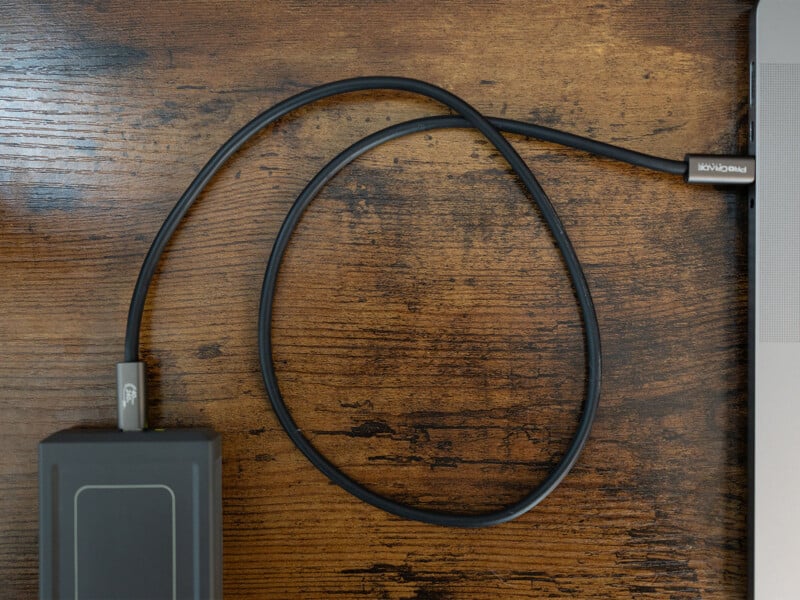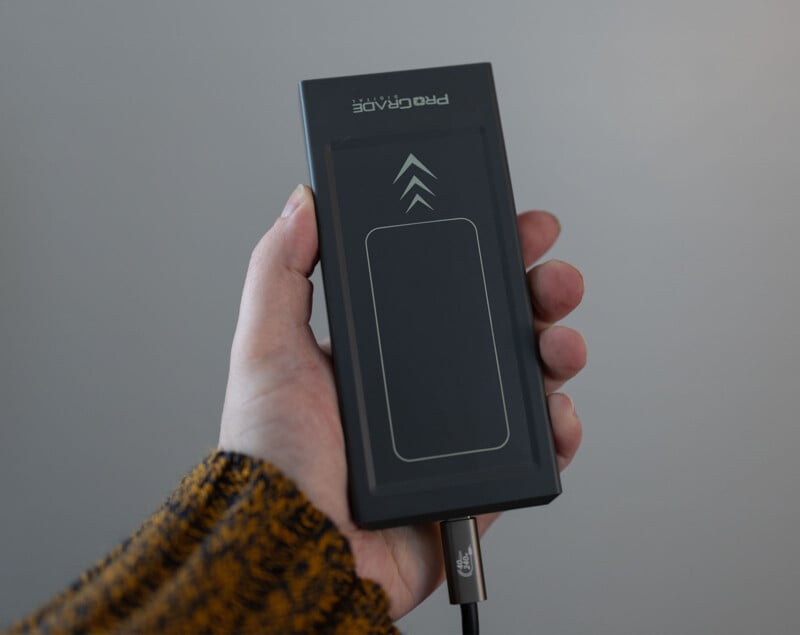[ad_1]
![]()
ProGrade’s new PG10 SSD, out there in 2TB, 4TB, and 8TB capacities, sports activities quick USB 4.0 expertise and guarantees swift most speeds. Nonetheless, whereas it’s not the quickest drive briefly sprints we’ve examined, its major attraction is sustained efficiency, even when transferring enormous batches of recordsdata.
I’ve examined my justifiable share of SSD models for PetaPixel, and whereas lots of them are moderately fast at their finest, fairly just a few battle when dealing with enormous recordsdata over prolonged durations. Many drives, particularly ones designed to be ultra-portable, get sizzling and noticeably decelerate. Others can cope with caching points the place speeds scale back to a crawl.
Design and Usability
Earlier than moving into efficiency, I’d like to start out with the PG10’s design. Whereas many transportable SSDs purpose to be as compact as attainable, typically to the detriment of sustained efficiency, the PG10 goes a special route. It’s a fairly large SSD, about 6.75 inches (17.1 centimeters) lengthy, 2.5 inches (6.4 centimeters) large, and 0.75 inches (1.9 centimeters) thick. It weighs slightly below 10.5 ounces (round 297 grams).
![]()
It’s not a small drive, however that is thanks partly to an inner twin heatsink construction, which helps drive the efficiency. That is undoubtedly a worthwhile tradeoff for an influence consumer who wants to maneuver giant recordsdata shortly. Somebody who prioritizes a compact kind issue will need to look elsewhere.
The PG10’s general design is kind of pretty. The medium-gray system isn’t probably the most glossy SSD I’ve ever used, but it surely appears to be like skilled. Extra importantly, its design is utilitarian. A lightweight define on prime is completely sized for industry-standard Avery sticker labels.
![]()
The system has a standing gentle on the entrance and a small energy gentle on the again subsequent to the USB-C port. The facility gentle works alongside a patent-pending inner circuit, informing you if their pc provides the required 15 watts of energy to the drive for optimum efficiency.
The underside of the system has a rubber foot, which retains the drive steady on my desk. Nonetheless, if another person’s desk is just too slick, the drive can be magnetic and ships with a metallic piece you possibly can keep on with your work floor. The magnetic foot additionally lets customers stack a number of PG10 drives on prime of one another.
These are all considerate, welcome inclusions. One other one is that the PG10 ships with a one-meter-long USB 4-certified cable that’s now formally the perfect USB cable I personal. I’ve loads of USB cables round, however this one is genuinely glorious. For many who have by no means struggled with rubbish cables earlier than, together with many who aren’t labeled with their rated speeds, this may occasionally appear to be a wierd factor to be excited by. However belief me, when you’ve recognized the ache of shoddy cables, you come to understand good ones, and the PG10’s included cable is way more than merely good.

The system additionally comes with a rugged clamshell onerous case with a padded inside, with area for the included cable and the magnetic metallic base. I continuously journey with drives so I can backup picture recordsdata on the go, and the PG10’s case is ideal for tossing in a bag. ProGrade says it’s sturdy sufficient to ship, and I imagine it, however I’d in all probability nonetheless put it inside a padded envelope or one thing first — simply in case.
Efficiency
That is an fascinating part and one which requires cautious evaluation. Let’s begin with most speeds. ProGrade Digital says the PG10 can obtain peak learn and write speeds of as much as 2,500 MB/s, which could be very fast, however not the quickest USB 4 drive we’ve seen. It’s additionally not as quick as some Thunderbolt drives, no less than in idea.
Nonetheless, in my testing, I couldn’t obtain these speeds. As a substitute, I topped out at round 1,720 MB/s write speeds and 1,793 MB/s learn speeds utilizing Blackmagic’s Disk Pace Take a look at. I talked about this immediately with ProGrade Digital, and the corporate suggested that pace assessments like this don’t completely replicate real-world efficiency. I settle for the premise that there’s extra to a drive’s efficiency than a pace check outcome, however for consistency with different opinions, we will need to have some form of benchmark. And on our typical benchmark, the PG10 is simply not hitting its goal, though it’s speedy.

The place the PG10 excels, nevertheless, is relating to sustained efficiency. It’s a enormous level of emphasis for ProGrade Digital that the PG10 delivers its promised sustained write pace (1,500 MB/s for the 2TB model and a pair of,000 MB/s for the 4TB and 8TB drives) even when filling the drive up in a single fell swoop.

I threw every little thing I may at this drive, hitting it with giant transfers after giant transfers, and it not solely maintained the identical speeds — slightly below 1,800 MB/s — the whole time, however the drive by no means obtained sizzling. It obtained heat to the contact, in fact, however not uncomfortably sizzling. Because it’s an SSD, it’s additionally completely silent.

Efficiency didn’t degrade or take successful because the drive stuffed, both, which might often be a problem for some SSDs I’ve used. Even when full, with simply sufficient area left for the Blackmagic disk check, the drive didn’t miss a beat. Actually, it was truly barely sooner in testing than when it was empty.

The ProGrade PG10 Matches My Workflow
Whereas some drives are sooner than the ProGrade PG10, a truth the corporate readily admits, ProGrade thinks that the PG10 is best suited to how most individuals use exterior SSDs — transferring quite a lot of information concurrently. For my part, ProGrade is appropriate. The PG10 is constructed to deal with precisely how I take advantage of SSDs, and I admire that the estimated time to switch terabytes of information on my MacBook Professional (M1 Max) proved correct, which isn’t as frequent as one may hope.

When I’m making an attempt to maneuver total years’ price of RAW pictures or again up card after card after taking pictures, I would like the method to go as easily as attainable, and which means the final file strikes to the drive as shortly because the very first file. The PG10 achieves this, and it’s an unusual feat.

Are There Options?
Sure, there are. ProGrade considers the OWC Specific 1M2 its major competitors, and I agree with the evaluation. OWC’s USB 4 drive guarantees superior peak pace than the PG10, though ProGrade’s testing — which PetaPixel noticed — exhibits the PG10 wins out when it comes to sustained efficiency over colossal information transfers. They match totally different workflows, primarily, though each are fairly clearly quick. The OWC Specific 1M2 begins at $249 for the 1TB model, ranging as much as $1,399 for the 8TB variant. The ProGrade Digital PG10 can be $1,399 for the 8TB model, which is not any coincidence.
Another choice, albeit one that’s, for now, onerous to totally make the most of, is OWC’s first Thunderbolt 5 transportable SSD, the Envoy Extremely. This drive, anticipated to reach subsequent month, is available in 2TB ($400) and 4TB ($600) capacities and guarantees speeds over 6,000 MB/s when used on a Thunderbolt 5-equipped machine. To date, no Mac has TB5 ports, however they’re undoubtedly coming in some unspecified time in the future.
![]()
Ought to You Purchase It?
Sure. For customers who worth a large-capacity SSD that delivers robust efficiency throughout large information transfers, the ProGrade Digital PG10 is an distinctive possibility. It’s remarkably constant and steady underneath excessive stress. When transferring and storing my most valuable recordsdata, there may be little I worth greater than stability.
[ad_2]
Jeremy Grey
2024-09-27 15:01:57
Source hyperlink:https://petapixel.com/2024/09/27/prograde-pg10-ssd-review-usb4-drive-delivers-fantastic-sustained-performance/

